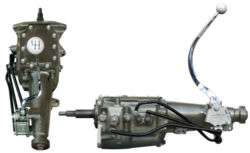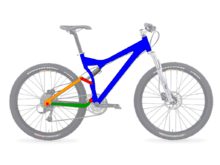Four-bar linkage
A four-bar linkage, also called a four-bar, is the simplest movable closed-chain linkage. It consists of four bodies, called bars or links, connected in a loop by four joints. Generally, the joints are configured so the links move in parallel planes, and the assembly is called a planar four-bar linkage. Spherical and spatial four-bar linkages also exist and are used in practice.[1]

Planar four-bar linkage

Planar four-bar linkages are constructed from four links connected in a loop by four one-degree-of-freedom joints. A joint may be either a revolute, that is a hinged joint, denoted by R, or a prismatic, as sliding joint, denoted by P.
A link connected to ground by a hinged joint is usually called a crank. A link connected to ground by a prismatic joint is called a slider. Sliders are sometimes considered to be cranks that have a hinged pivot at an extremely long distance away perpendicular to the travel of the slider.
The link that connects two cranks is called a floating link or coupler. A coupler that connects a crank and a slider is often called a connecting rod.
There are three basic types of planar four-bar linkage depending on the use of revolute or prismatic joints:
- Four revolute joints: The planar quadrilateral linkage is formed by four links and four revolute joints, denoted RRRR. It consists of two cranks connected by a coupler.
- Three revolute joints and a prismatic joint: The slider-crank linkage is constructed from four links connected by three revolute and one prismatic joint, or RRRP. It can be constructed with crank and a slider connected by the connecting rod. Or it can be constructed as a two cranks with the slider acting as the coupler, known as an inverted slider-crank.
- Two revolute joints and two prismatic joints: The double slider is a PRRP linkage.[2] This linkage is constructed by connecting two sliders with a coupler link. If the directions of movement of the two sliders are perpendicular then the trajectories of the points in the coupler are ellipses and the linkage is known as an elliptical trammel, or the Trammel of Archimedes.
Planar four-bar linkages are important mechanisms found in machines. The kinematics and dynamics of planar four-bar linkages are important topics in mechanical engineering.
Planar four-bar linkages can be designed to guide a wide variety of movements.
Planar quadrilateral linkage
Planar quadrilateral linkage, RRRR or 4R linkages have four rotating joints. One link of the chain is usually fixed, and is called the ground link, fixed link, or the frame. The two links connected to the frame are called the grounded links and are generally the input and output links of the system, sometimes called the input link and output link. The last link is the floating link, which is also called a coupler or connecting rod because it connects an input to the output.
Assuming the frame is horizontal there are four possibilities for the input and output links:[2]
- A crank: can rotate a full 360 degrees
- A rocker: can rotate through a limited range of angles which does not include 0° or 180°
- A 0-rocker: can rotate through a limited range of angles which includes 0° but not 180°
- A π-rocker: can rotate through a limited range of angles which includes 180° but not 0°
Some authors do not distinguish between the types of rocker.
Grashof condition
The Grashof condition for a four-bar linkage states: If the sum of the shortest and longest link of a planar quadrilateral linkage is less than or equal to the sum of the remaining two links, then the shortest link can rotate fully with respect to a neighboring link. In other words, the condition is satisfied if S + L ≤ P + Q, where S is the shortest link, L is the longest, and P and Q are the other links.
Classification
The movement of a quadrilateral linkage can be classified into eight cases based on the dimensions of its four links. Let a, b, g and h denote the lengths of the input crank, the output crank, the ground link and floating link, respectively. Then, we can construct the three terms:
- ;
- ;
- .
The movement of a quadrilateral linkage can be classified into eight types based on the positive and negative values for these three terms, T1, T2, and T3.[2]
| Grashof condition | Input link | Output link | |||
|---|---|---|---|---|---|
| − | − | + | Grashof | Crank | Crank |
| + | + | + | Grashof | Crank | Rocker |
| + | − | − | Grashof | Rocker | Crank |
| − | + | − | Grashof | Rocker | Rocker |
| − | − | − | Non-Grashof | 0-Rocker | 0-Rocker |
| − | + | + | Non-Grashof | π-Rocker | π-Rocker |
| + | − | + | Non-Grashof | π-Rocker | 0-Rocker |
| + | + | − | Non-Grashof | 0-Rocker | π-Rocker |
The cases of T1 = 0, T2 = 0, and T3 = 0 are interesting because the linkages fold. If we distinguish folding quadrilateral linkage, then there are 27 different cases.
The figure shows examples of the various cases for a planar quadrilateral linkage.[3]


The configuration of a quadrilateral linkage may be classified into three types: convex, concave, and crossing. In the convex and concave cases no two links cross over each other. In the crossing linkage two links cross over each other. In the convex case all four internal angles are less than 180 degrees, and in the concave configuration one internal angle is greater than 180 degrees. There exists a simple geometrical relationship between the lengths of the two diagonals of the quadrilateral. For convex and crossing linkages, the length of one diagonal increases if and only if the other decreases. On the other hand, for nonconvex non-crossing linkages, the opposite is the case; one diagonal increases if and only if the other also increases.[4]
Design of four-bar mechanisms
The synthesis, or design, of four-bar mechanisms is important when aiming to produce a desired output motion for a specific input motion. In order to minimize cost and maximize efficiency, a designer will choose the simplest mechanism possible to accomplish the desired motion. When selecting a mechanism type to be designed, link lengths must be determined by a process called dimensional synthesis. Dimensional synthesis involves an iterate-and-analyze methodology which in certain circumstances can be an inefficient process; however, in unique scenarios, exact and detailed procedures to design an accurate mechanism may not exist.[5]
Time ratio
The time ratio (Q) of a four-bar mechanism is a measure of its quick return and is defined as follows:[5]
With four-bar mechanisms there are two strokes, the forward and return, which when added together create a cycle. Each stroke may be identical or have different average speeds. The time ratio numerically defines how fast the forward stroke is compared to the quicker return stroke. The total cycle time (Δtcycle) for a mechanism is:[5]
Most four-bar mechanisms are driven by a rotational actuator, or crank, that requires a specific constant speed. This required speed (ωcrank)is related to the cycle time as follows:[5]
Some mechanisms that produce reciprocating, or repeating, motion are designed to produce symmetrical motion. That is, the forward stroke of the machine moves at the same pace as the return stroke. These mechanisms, which are often referred to as in-line design, usually do work in both directions, as they exert the same force in both directions.[5]
Examples of symmetrical motion mechanisms include:
- Windshield wipers
- Engine mechanisms or pistons
- Automobile window crank
Other applications require that the mechanism-to-be-designed has a faster average speed in one direction than the other. This category of mechanism is most desired for design when work is only required to operate in one direction. The speed at which this one stroke operates is also very important in certain machine applications. In general, the return and work-non-intensive stroke should be accomplished as fast as possible. This is so the majority of time in each cycle is allotted for the work-intensive stroke. These quick-return mechanisms are often referred to as offset.[5]
Examples of offset mechanisms include:
- Cutting machines
- Package-moving devices
With offset mechanisms, it is very important to understand how and to what degree the offset affects the time ratio. To relate the geometry of a specific linkage to the timing of the stroke, an imbalance angle (β) is used. This angle is related to the time ratio, Q, as follows:[5]
Through simple algebraic rearrangement, this equation can be rewritten to solve for β:[5]
Timing charts
Timing charts are often used to synchronize the motion between two or more mechanisms. They graphically display information showing where and when each mechanism is stationary or performing its forward and return strokes. Timing charts allow designers to qualitatively describe the required kinematic behavior of a mechanism.[5]
These charts are also used to estimate the velocities and accelerations of certain four-bar links. The velocity of a link is the time rate at which its position is changing, while the link's acceleration is the time rate at which its velocity is changing. Both velocity and acceleration are vector quantities, in that they have both magnitude and direction; however, only their magnitudes are used in timing charts. When used with two mechanisms, timing charts assume constant acceleration. This assumption produces polynomial equations for velocity as a function of time. Constant acceleration allows for the velocity vs. time graph to appear as straight lines, thus designating a relationship between displacement (ΔR), maximum velocity (vpeak), acceleration (a), and time(Δt). The following equations show this.[5][6]
- ΔR = 1/2vpeakΔt
- ΔR = 1/4a(Δt)2
Given the displacement and time, both the maximum velocity and acceleration of each mechanism in a given pair can be calculated.[5]
Slider-crank linkage
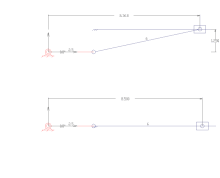
A slider-crank linkage is a four-bar linkage with three revolute joints and one prismatic, or sliding, joint. The rotation of the crank drives the linear movement the slider, or the expansion of gases against a sliding piston in a cylinder can drive the rotation of the crank.
There are two types of slider-cranks: in-line and offset.
- In-line
- An in-line slider-crank has its slider positioned so the line of travel of the hinged joint of the slider passes through the base joint of the crank. This creates a symmetric slider movement back and forth as the crank rotates.
- Offset
- If the line of travel of the hinged joint of the slider does not pass through the base pivot of the crank, the slider movement is not symmetric. It moves faster in one direction than the other. This is called a quick-return mechanism.
Spherical and spatial four-bar linkages
If the linkage has four hinged joints with axes angled to intersect in a single point, then the links move on concentric spheres and the assembly is called a spherical four-bar linkage. The input-output equations of a spherical four-bar linkage can be applied to spatial four-bar linkages when the variables are replaced by dual numbers.[7]
Bennett's linkage is a spatial four-bar linkage with hinged joints that have their axes angled in a particular way that makes the system movable.[8][2]
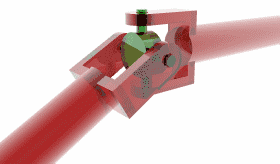 Universal joint.
Universal joint.- Tractor steering
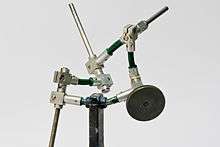 Bennett four-bar linkage.
Bennett four-bar linkage.
Examples
- Biological linkages
- Bicycle suspension
- Door closer
- Pantograph (four-bar, two degrees of freedom, i.e., only one pivot joint is fixed.)
- Pumpjack
- Double wishbone suspension
- Foot operated machines i.e. treadle sewing machine, grindstone, lathe etc.
- Glider (furniture)
- Foldable steps and foldable chairs
- Step-on trash can
- Gear shift linkages
- Steam engines and locomotives
- Oscillating fan
- Watt's linkage and Chebyshev linkage (linkages that approximate straight-line motion)
- Windshield wiper
Example simulations
 Crank-rocker stops at the limit positions and at min/max transmission angle
Crank-rocker stops at the limit positions and at min/max transmission angle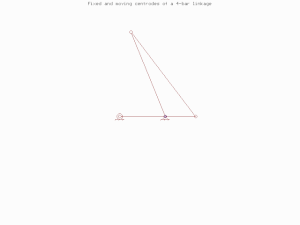 Fixed and moving centrodes of a four-bar
Fixed and moving centrodes of a four-bar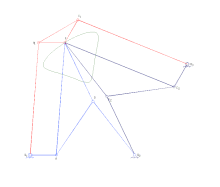 Coupler cognates of a crank-rocker four-bar
Coupler cognates of a crank-rocker four-bar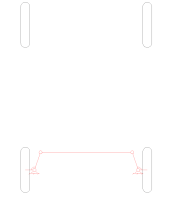 four-bar type (Ackerman) steering linkage
four-bar type (Ackerman) steering linkage.gif) Four-bar function generator
Four-bar function generator Turning coupler four-bar linkages
Turning coupler four-bar linkages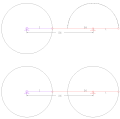 Parallel four-bar linkages
Parallel four-bar linkages Galloway (deltoid or kite) four-bar linkage
Galloway (deltoid or kite) four-bar linkage Folding crank-rocker four-bar linkage
Folding crank-rocker four-bar linkage
See also
References
- Hartenberg, R.S. & J. Denavit (1964) Kinematic synthesis of linkages, New York: McGraw-Hill, online link from Cornell University.
- J. M. McCarthy and G. S. Soh, Geometric Design of Linkages, 2nd Edition, Springer, 2010
- Design of Machinery 3/e, Robert L. Norton, 2 May 2003, McGraw Hill. ISBN 0-07-247046-1
- Toussaint, G. T., "Simple proofs of a geometric property of four-bar linkages", American Mathematical Monthly, June–July 2003, pp. 482–494.
- Myszka, David (2012). Machines and Mechanisms: Applied Kinematic Analysis. New Jersey: Pearson Education. ISBN 978-0-13-215780-3.
- Chakrabarti, Amaresh (2002). Engineering Design Synthesis: Understanding, Approaches and Tools. Great Britain: Springer-Verlag London Limited. ISBN 978-1852334925.
- Angeles, Jorge (2012), "The Dual Generalized Inverses and Their Applications in Kinematic Synthesis", Latest Advances in Robot Kinematics, Springer Netherlands, pp. 1–10, doi:10.1007/978-94-007-4620-6_1, ISBN 9789400746190
- Hunt, K. H., Kinematic Geometry of Mechanisms, Oxford Engineering Science Series, 1979
.jpg)


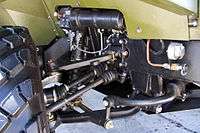


.jpg)
